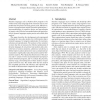275 search results - page 53 / 55 » Sequential Construction of Logical Forms |
JETAI
2007
13 years 7 months ago
2007
Reasoning, problem solving, indeed the general process of acquiring knowledge, is not an isolated, homogenous affair involving a one agent using a single form of representation, b...
DLS
2010
13 years 5 months ago
2010
Dynamic languages such as Python allow programs to be written more easily using high-level constructs such as comprehensions for queries and using generic code. Efficient executio...
EUSFLAT
2009
13 years 5 months ago
2009
Abstract-- An L-fuzzy context is a triple consisting of a set of objects, a set of attributes and an L-fuzzy binary relation between them. An l-cut is a classical context over the ...
POPL
2006
ACM
14 years 8 months ago
2006
ACM
Web applications typically interact with a back-end database to retrieve persistent data and then present the data to the user as dynamically generated output, such as HTML web pa...
RECOMB
2007
Springer
14 years 8 months ago
2007
Springer
Association, or LD (linkage disequilibrium), mapping is an intensely-studied approach to gene mapping (genome-wide or in candidate regions) that is widely hoped to be able to effic...

